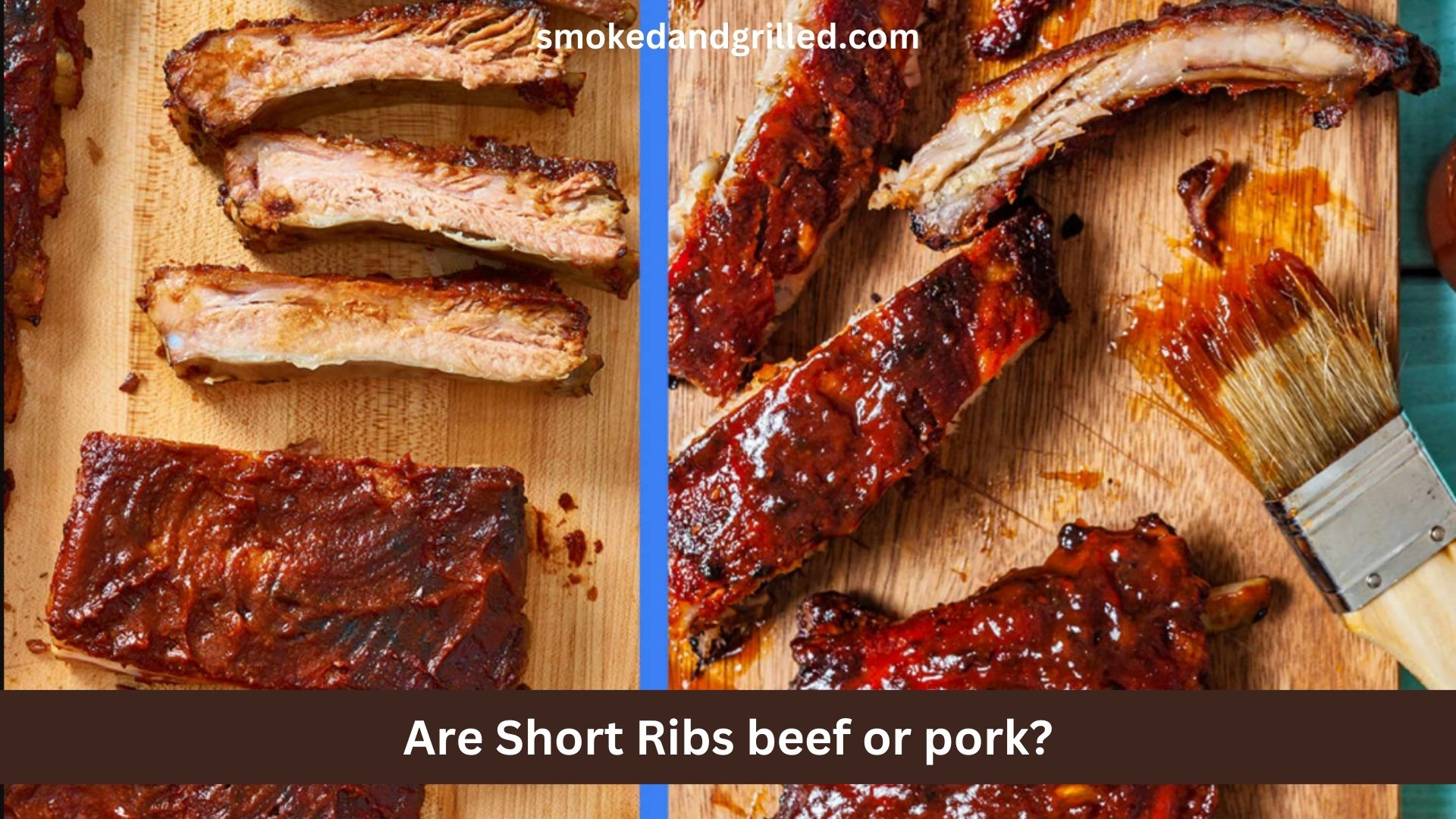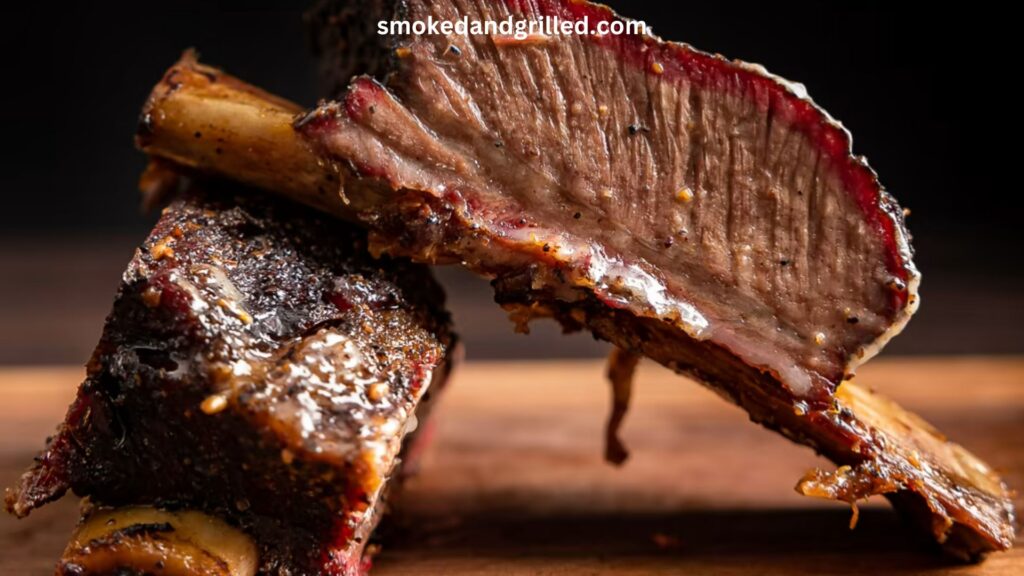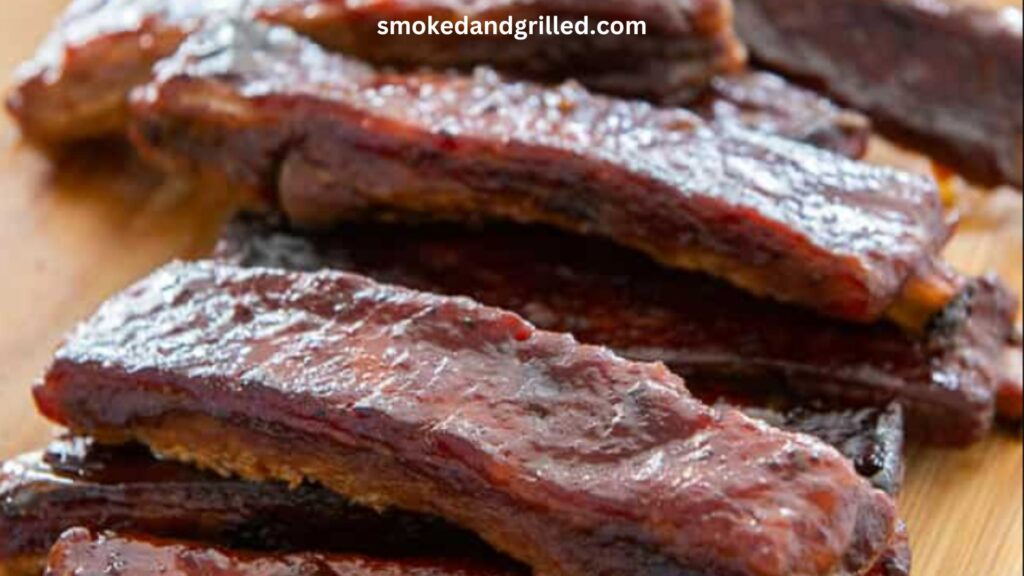Short ribs are always a hit, whether you braise, grill, or smoke them. But what are short ribs exactly, and are they made of beef or pork?
So the next time you want a filling and tasty meal, grab some short ribs. You will not be let down.
Are Short Ribs Beef Or Pork?
Short ribs are a cut of beef from the cow’s chuck, plate, rib, or brisket area. They are called “short” ribs because they are shorter than pork spareribs, which come from the same part of the pig.
There are two main ways to cut short ribs: the English cut and the flanken cut. Short ribs with an English cut are cut along the bone, while short ribs with a flanken cut are cut across the bone.
The best way to make short ribs is to braise them, which is a slow cooking method that uses moist heat.
When you braise short ribs, the connective tissue breaks down and the meat gets tender.
There are many ways to cook short ribs, but the most common way is to braise them in a pot or Dutch oven.
You could also grill, smoke, or roast them. Short ribs are used in many popular dishes, like beef stew, chili, and barbecue.
Short ribs are not found in pork. Spareribs are the pork cut that is most like beef short ribs.
They are usually shorter than beef short ribs and have less meat on them. Most of the time, spareribs are grilled or smoked, but they can also be braised.
Short Ribs Anatomy
Short ribs are a cut of beef or pork meat that comes from the rib area of the animal. The structure of short ribs can be a little different depending on the animal and how it was butchered.
Here’s a general look at how beef or pork short ribs are made:
1. Short Ribs Of Beef
Beef short ribs come from a cow’s chuck, plate, rib, or brisket area. They are made up of a short piece of rib bone and the meat around it, which usually has a lot of fat in it.
Short ribs from beef tend to be bigger than short ribs from pork. They can be between 2 and 4 inches long and between 1 and 2 inches thick.
Short ribs of beef are usually braised, which is a slow cooking method that breaks down the connective tissue in the meat by using moist heat. By braising, the ribs get soft and full of flavor.
Beef short ribs are a common part of many popular dishes, like beef stew, chili, and barbecue.
2. Short Ribs Of Pork
The belly of the pig is where pork short ribs come from. They are made up of a short piece of rib bone and the meat around it, which is usually leaner than beef short ribs.
Short ribs from pork are usually smaller than short ribs from beef. They can be between 1 and 2 inches long and between 1/2 and 1 inch thick.
Pork short ribs can be cooked in many different ways, but the most common ways are to grill or smoke them. Ribs get a smokey taste when they are grilled or smoked.
Short ribs from pork are used in many popular dishes, like pulled pork sandwiches, barbecue, and tacos.
Beef Short Ribs
Here’s a table explaining the different parts of beef short ribs:
| Beef Short Ribs Anatomy | Description |
| Cut | From the bottom part of the rib cage (typically 6th to 12th rib). |
| Bones | It contains rib bones that have been cut in half. |
| Meat | It is filled with fat and wraps around the bones. |
| Fat | Marbled through the meat, which adds flavor and makes it more tender. |
| Connective Tissue | There between the meat and the bones. When cooked slowly, it makes the meat taste and feel richer. |
| Texture | When cooked right, meat is usually tender and juicy. |
| Flavor | Rich and hearty, the marbling and fat content often make it even better. |
| Cooking Methods | Most of the time, meat is braised, slow-cooked, grilled, or smoked to make it tender and add flavor. |
| Serving Size | Usually, there is one bone and a lot of meat on each short rib. |
Pork Short Ribs
Certainly! Here’s a table explaining the different components of pork short ribs:
| Component | Explanation |
| Bones | Short ribs of pork usually have rib bones in them, which add flavor and structure while cooking. They can be different sizes and sometimes have meat on them. |
| Meat | Most of the meat on pork short ribs is in and around the rib bones. Compared to beef short ribs, it is usually leaner and may have a layer of fat on the outside. |
| Fat | Most of the time, pork short ribs have a thin layer of fat on top of the meat. This fat adds moisture and helps the ribs taste good and be tender when they are cooked. |
| Connective Tissue | Like other cuts of meat, pork short ribs have connective tissue that breaks down when they are cooked. This makes them soft and tender. This tissue helps the meat stay moist and gives it a rich taste. |
| Marbling | Even though pork is usually less marbled than beef, some pork short ribs may have small streaks or pockets of fat inside the muscle. These patterns in the fat make the meat taste better and keep it moist. |
| Rib Tips | The “rib tips” or cartilage-rich ends of the ribs can be part of pork short ribs. These parts can give the whole dish more texture and flavor. |
What Is The Main Protein Source For Short Ribs, Pork Or Beef?
Whether you’re talking about pork or beef short ribs, the main source of protein is different. Beef is the main source of protein for beef short ribs.
When it comes to pork short ribs, pork is the main source of protein.
Pork is also a good source of protein because it contains essential amino acids that the body needs to do many different things.
Pork short ribs add to the total amount of protein and can be a tasty way to get protein.
It’s important to note that both beef and pork are great sources of protein.
Which one you choose depends on your personal tastes, your diet, and your cultural or culinary preferences.
Cooking Methods
below are the cooking methods of both ribs;
“The Sweet Melody of Grilling”: Pork Short Ribs.
When you think of pork short ribs, picture a symphony of sizzling sounds made by flames dancing around the meat.
As the ribs sizzle on the grill, the heat slowly turns the meat into a delicious caramelized crust. The tender meat smells like smoke, which makes you want to eat it.
Just like a well-choreographed dance, you can baste the ribs with a tangy barbecue sauce to add layers of flavor to the show.
What happened? Short ribs of pork that are sweet and smokey in just the right amounts.
“The Slow Serenade of Braising”: Beef Short Ribs.
Think of a pot on the stove where beef short ribs move and soften in a fragrant melody of flavors as the pot simmers.
Covered and cooked low and slow, the gentle heat wraps around the ribs, making the meat tender and letting the flavors mix.
What happened? Beef short ribs that are soft, juicy, and full of flavors that make you want to savor every bite.
Flavor Pairings
Here’s a table showcasing flavor pairings that complement both pork and beef short ribs:
| Flavor Pairing | Pork Short Ribs | Beef Spare Ribs |
| Sweet | Apple, peach, honey, brown sugar | Maple syrup, balsamic glaze, caramelized onions |
| Tangy | Barbecue sauce, citrus (lemon, orange) | Red wine reduction, Worcestershire sauce |
| Spicy | Chipotle, chili powder, paprika | Black pepper, cayenne pepper, horseradish |
| Savory | Garlic, thyme, rosemary, soy sauce | Red wine, garlic butter, mushroom |
| Smoky | Hickory, mesquite, smoked paprika | Smoked sea salt, coffee rub, smoked cheese |
| Herbal | Sage, parsley, cilantro, basil | Oregano, tarragon, parsley, thyme |
| Earthy | Mushrooms, roasted root vegetables | Red wine, truffle oil, roasted garlic |
| Fruity | Plum, cherry, fig, cranberry | Red wine reduction, blueberry sauce |
Can Short Ribs Be Made From Both Pork And Beef?
The chuck, plate, or brisket part of a cow is where short ribs come from.
During cooking, the fat in the meat helps keep the ribs moist and tender.
There is no cut of pork meat that is the same as beef short ribs. Spareribs are the closest thing to it in pork.
Spareribs are cut in the same direction as the bone and come from the pig’s belly.
They are usually shorter than beef short ribs and have less meat on them. Most of the time, spareribs are grilled or smoked, but they can also be braised.
Because the structure of a cow’s rib cage is different from that of a pig’s, short ribs can only be made from beef.
Because the pig’s rib cage is smaller and has fewer bones, pork short ribs are smaller and have less meat.
In short, short ribs can only be made from beef because a cow’s rib cage is made in a way that makes the short ribs longer and meatier.
Pork doesn’t have a cut of meat that is the same as beef short ribs, and pork spareribs are usually smaller and less meaty than beef short ribs.
How Do I Determine If My Short Ribs Are Pork Or Beef?
You can use the following ways to figure out if your short ribs are pork or beef:
1. Labeling
Look at the package or label to see what it says. It should be clear if the short ribs are made of pork or beef.
Look for words on the package like “pork short ribs” or “beef short ribs.”
2. Look
Look at the short ribs to see what they look like.
Most of the time, beef short ribs are bigger and have more visible fat marbling throughout the meat.
Short ribs from pork tend to be smaller, leaner, and have less fat that you can see.
3. Butcher Or Merchant
If you bought the short ribs from a butcher or other meat supplier, they should be able to tell you if they are pork or beef.
They can give accurate information because of how they get their meat and how they cut it up.
4. Consult A Recipe
If you have a specific recipe in mind, it may tell you if you need pork or beef short ribs.
The instructions for a recipe can help you figure out what kind of meat to use.
FAQs
Are Short Ribs Healthy?
Whether they are made of pork or beef, short ribs have a rich flavor and lot of flavor, but they are not considered lean cuts of meat.
They have about the same amount of fat as leaner cuts but can have more calories. But short ribs are also a good source of essential nutrients like protein, vitamins, and minerals.
As with any food, you should eat in moderation. As part of a balanced diet, short ribs can be part of a healthy way of life.
Can I Use Beef Short Ribs Instead Of Pork Short Ribs In A Recipe?
Yes, beef short ribs can be used in a recipe instead of pork short ribs.
Keep in mind that beef short ribs have a different taste, and their size and fat content may mean that they need to be cooked in a slightly different way.
Changing the cooking time and flavors to fit the beef short ribs will help make sure that the result is delicious.
How Can I Make Sure That My Short Ribs Are Tender?
To make sure short ribs are tender, it’s best to use cooking methods like braising or slow cooking that use low heat for a long time.
This helps break down the meat’s connective tissues and collagen, making the ribs soft and tasty.
Adding moisture, like a tasty braising liquid or marinade, can also make the meat more tender.
To get short ribs to the tenderness you want, you have to cook them slowly.
Should I Trim The Fat Off My Short Ribs Before Cooking?
It’s up to you if you want to cut the extra fat off of short ribs.
Fat can add flavor and moisture to food when it’s being cooked, but some people prefer to cut away extra fat for health or texture reasons.
It’s best to leave a good amount of fat on the ribs because it adds flavor and makes the meat tender.
But if you want, you can cut off any extra or unwanted fat before cooking.
What Is The Difference Between Short Ribs And Spare Ribs?
There are different cuts of meat called short ribs and spare ribs. Short ribs come from the area of the animal between the ribs and the plate or chuck.
Most of the time, they are smaller, have more meat, and are cut into shorter lengths.
On the other hand, spare ribs come from the lower part of the rib cage, which is closer to the belly. They have more bone and cartilage and are bigger and longer.
Spare ribs are usually cooked on the grill, while short ribs are usually braised or cooked slowly.
How Many Calories Are In Short Ribs?
The number of calories in short ribs can change depending on things like the cut, how they are cooked, and how much fat they have.
On average, a serving of cooked beef short ribs that is 3 ounces (85 grams) can have between 250 and 350 calories.
A similar-sized serving of pork short ribs usually has between 200 and 300 calories less than a similar-sized serving of beef short ribs.
It’s important to remember that these values are estimates that can change depending on how the food is made and what ingredients are used.
Conclusion
Short ribs are indeed beef, not pork. This succulent and flavorful cut of meat comes from the beef rib section, specifically from the lower portion of the ribcage.
Short ribs are known for their rich marbling and tender texture, making them a popular choice for braising, grilling, or slow cooking.
Whether enjoyed as a hearty meal or incorporated into various culinary creations, beef short ribs offer a delicious and satisfying experience for meat lovers.



